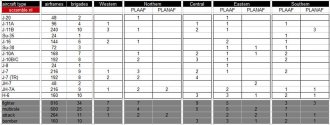It doesn't need to be a reduction.
Last year I made a table of PLAAF and PLANAF units using
scramble orbat with 2020 data. There is a margin of error and uncertainty involved but it looked like this:
View attachment 99954
The orbat listed 11 JH-7/A units with a total of
264 aircraft:
- 2 JH-7 units in PLANAF (2 ETC) - 48 aircraft
- 3 JH-7A units in PLANAF (2 NTC, 1 STC) - 72 aircraft
- 6 JH-7A units in PLAAF (1 WTC, 2 NTC, 2 ETC, 1 STC) - 144 aircraft
Recently the
YT channel Binkov's Battlegrounds made a video on PLA air force modernization and while I can't assess the quality of data (that's yours and Deino's field) I'll use it for this exercise:
J-10C
deliveries - 230 total:
2015 - 12, 2016 - 24, 2017 - 30, 2018 - 35, 2019 - 35, 2020 - 35, 2021 - 35, 2022 - 24
units - ?
J-16
deliveries - 222 total:
2015 - 8, 2016 - 16, 2017 - 22, 2018 - 28, 2019 - 32, 2020 - 36, 2021 - 40, 2022 - 40
units - 9?
J-20
deliveries - 126 total (speculative):
2016 - 4, 2017 - 8, 2018 - 12, 2019 - 18, 2020 - 24, 2021 - 30, 2022 - 30
units - 5?
If you compare those figures to those in my table there's a difference of 93 J-10C (excluding 55 J-10B), 78 J-16 and 78 J-20 which combined give
249 aircraft. This figure is on its own sufficient to cover all withdrawn JH-7/A.
If the rumor indicates 2025 it means that we have between two more years of production to fill the gap. At current rates of production indicated in Binkov video of 24 J-10C, 40 J-16 and 30 J-20 that gives 48 J-10C, 80 J-16 and 60 J-20 for a total of
188 new aircraft to replace moved or retired aircraft, excluding any 2025 production to meet the 2025 retirement deadline without significant loss to readiness.
If the above figures are close to what you and Deino estimate there's already a safe margin for withdrawal of JH-7/A that is only limited by the intended aircraft distribution in the units.
As for retiring J-7 I don't think all of J-7s need to be retired before 2025 for a simple reason - unlike JH-7 the J-7 is a cheap platform for performing of secondary tasks in the field of air defense and airspace protection. JH-7 is a heavy twin-engine strike aircraft in a similar class as J-16 (14,5t empty weight vs 17,7 empty weight) but comparably with very limited capabilities. Most importantly it can't perform air superiority tasks like the J-16 which greatly limits its combat role in any plausible scenario. Both J-10C and J-16 are preferable, even excluding the issues of logistics and maintenance.
J-7 can still fly air patrols, respond to airspace violations and shoot down cruise missiles. It can still perform those roles safely along the central-northern (Mongolia) and south-western (Myanmar, Laos, Vietam) borders in cooperation with other fighters in main roles. Not to mention it can be expended to countries like North Korea, Bangladesh, Cambodia etc if necessary.
It also serves as a introductory fighter and can be used to facilitate training which is the main bottleneck in force generation for PLAAF. Until there is sufficient number of LIFT trainers and twin-seaters J-7 will still have a role to play.
Retiring JH-7 has three beneficial results: (1) generates savings, (2) improves ground strike capabilities, (3) increases the number of air superiority assets available to planners. Retiring J-7 improves air-to-air capabilities and adds ground strike capability but at the increase of expenditures.
So while the rumor feels wrong the numbers suggest it might be right on the money. Personally I'd retire J-11A before J-7. It seems counter-intuitive if you only look at how a plane looks in stats or pictures but once you start crunching the boring numbers of logistics, force generation and retention and funding then it becomes rather obvious which is a better choice. At least this is my perspective on the issue.
Not to mention that if the numbers I cited are close to correct then in 2025 all three - JH-7, J-7 and J-11A - should have sufficient number of replacements and no reduction will be necessary.

